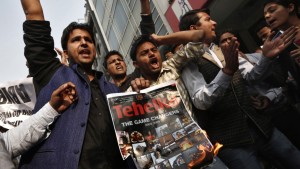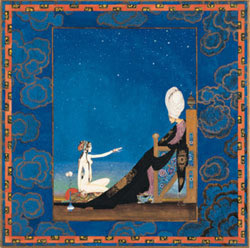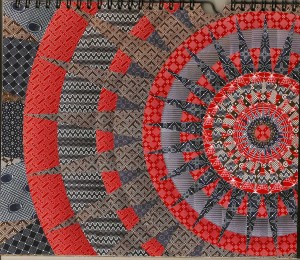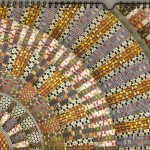“Operation West End“ – a sting carried out by two young journalists commissioned by the [...]]]>
“Operation West End“ – a sting carried out by two young journalists commissioned by the news site Tehelka (which literally means ‘sensation’) – changed the landscape of investigative journalism in India.
One hundred hours of footage and nearly $23,000 worth of bribes later, the public became privy to the rot at the core of the country’s political sphere: where high-level officials allowed themselves to be caught on tape accepting wads of cash in exchange for arms deals with Tehelka’s fictitious Regent Street-based weapons manufacturer ‘West End’.
Among those exposed by the sting operation were Bharatiya Janata Party (BJP) President Bangaru Laxman, Samata Party President Jaya Jaitley, and Brajesh Mishra, who at the time was serving as the National Security to then Prime Minister Atal Bihari Vajpayee.
Those familiar with the politics of the Hindu right wing recognized that these were not men who would take criticism lightly. Death threats came thick and fast to the doorstep of founding editor Tarun Tejpal. Tehelka’s investors were put behind bars. Police officers dug through the website’s coffers in search of any anomaly that would justify silencing the outspoken crew.
An office of 104 was reduced to just four in a matter of months.
But the ramparts of India’s free press held strong. The website re-launched as a magazine and became one of the loudest voices in the shrinking space of liberal, left-of-center debate.
Though the politicians were eventually forced to suspend their attack on Tehelka, the magazine’s insistence on exposing corruption and criminality within the ranks of the BJP kept the old grudge alive.
Today, 13 years after Operation West End – with Tejpal incarcerated in a Goa prison and the magazine whittled down to about 1/8 its former size – India’s media world is seeing just how deep the vendetta goes.
If your questions lies in the realm of “how and why” this happened, the answers can only be found in the worrying currents that are lapping at the foundation of the country’s fourth estate: the power and influence of the Hindu right.
Tejpal today stands accused of sexually assaulting a colleague at an event hosted annually by the magazine in the Western state of Goa. The case is based on several emails leaked to the press by the alleged victim, and Tejpal’s own decision (also leaked to the press) to step down from his position as editor-in-chief following the accusation.
The facts surrounding the case are heavily disputed. Tejpal has denied the allegation, while his former colleague stands firm that the incident amounted to rape under India’s revised penal code. CCTV footage from the night in question has yet to be released to the public.

Activists of the Akhil Bharatiya Vidyarthi Parishad (ABVP), linked to India’s main opposition Bharatiya Janata Party (BJP), shout slogans during a protest against Tarun Tejpal, editor-in-chief of India’s leading investigative magazine, Tehelka, in New Delhi, Nov. 22, 2013. Credit: Adnan Abidi/Reuters
What cannot be disputed is the Indian government’s swift reaction to this case, with the police breaking rest until Tejpal was behind bars.
But in the hubbub of the high-profile sex scandal, few have asked how a country usually so slow to respond to violations of women’s health and safety (let us never forget Jyoti Singh Pandey, who lay naked and battered on the side of a Delhi highway for several hours before anyone came to her aid) has been roused from its stupor to tackle this particular incident
Those who do ask are finding, as “Operation West End” found, the rot.
Arun Jaitley was the first person to name the incident a rape – not the alleged victim, not a judge nor medical officer, but a prominent politician with the BJP.
The first public address calling for Tejpal’s arrest was arranged by Meenakshi Lekhi – not a women’s rights activist, nor a police representative, but the spokesperson for the BJP.
Who first gloated, before Indian national media, that this incident would spell the end of Tehelka? Not media analysts or experts, but Bangaru Laxman, former BJP president, and the very same man who was caught on tape during Operation West End.
Meanwhile, Jaya Jaitley, whose name you will recall from the beginning of this piece, has used the media scandal as a platform from which to denounce the validity of Operation West End and its findings.
Few newsrooms have stitched these details together in a coherent narrative. Most are either reporting from outside the courtroom or from the lofty platform of women’s rights, where Tejpal has been branded guilty until proven innocent.
If the BJP’s crusade against Tehelka has been lost in the headlines about the entire episode, the Goa police have had an even better deal. Save for a lone article in the Times of India, no mention has been made of the hundreds of unsolved crimes simmering in the very state that hastened to open the gates of its Vasco jail to Tejpal.
Ironically, it was here, in Vasco, where a schoolgirl was raped in early 2013. The perpetrator, though identified, got away scot-free, joining the ranks of scores of thieves, rapists and gangsters who have evaded the local police force all year. Even the murders of local tourists and foreign nationals did not elicit the prompt police action that followed the case against Tejpal.
Goa’s Chief Minister Manohar Parrikar, otherwise known as the man holding the state’s purse strings and prison keys, also heppens to be a proud member of the BJP.
Pundits have painted what is now dubbed the ‘Tejpal/Tehelka Scandal’ as a victory for Indian women. A young journalist makes a stand for her rights, and presto – the accused is clapped in a cell. The world is safe once more.
But when politicians are able to seize upon and manipulate an incident of this nature to fulfill forgotten ends, the world is not safe. A magazine that was once a beacon is singing a swan song, and no one is asking about the hooded figures dancing on the freshly dug earth of its grave.
]]>Few observers would question that news coverage prior to the 2003 U.S.- led invasion of Iraq affected public perceptions about the threat posed by weapons of mass destruction. Are news media making the same mistakes in covering Iran’s nuclear program? In short, yes and no.
Post-war studies of news [...]]]>
Few observers would question that news coverage prior to the 2003 U.S.- led invasion of Iraq affected public perceptions about the threat posed by weapons of mass destruction. Are news media making the same mistakes in covering Iran’s nuclear program? In short, yes and no.
Post-war studies of news coverage leading up to the Iraq War found an over-reliance on White House sources, the use of imprecise language to describe the threat from various types of weapons of mass destruction, a focus on the agenda and policy prescriptions of senior U.S. officials, and the news coverage’s relatively narrow framing of events.
In a review of six leading American and British newspapers’ coverage of Iran’s nuclear program over the past four years, we found many of the same tendencies. Reporters and editors overwhelmingly relied on government officials to inform their reporting. As a result, officials’ framing of the threat posed by Iran and of the policy choices they considered set the tone for coverage: Would sanctions force Iranian concessions or would military strikes be necessary to slow Iranian nuclear advances? Little attention was paid to policy alternatives proposed by others, including more sustained diplomacy or deterrence. (The complete study of media coverage of Iran’s nuclear program can be found here.)
Newspaper coverage of Iranian nuclear intentions and capabilities also lacked precision, was inconsistent over time, and failed to provide adequate sourcing and context for claims. With a muddled understanding of the technical and political issues at the root of the dispute between Iran, the United States, European states (the so-called EU-3 – Britain, France, and German), and Israel, the discussion of policy options facilitated by the newspaper coverage was adrift and at times, misleading.
For example, when the U.N. Security Council debated an additional round of punitive economic sanctions against Iran in the first part of 2010, news coverage predominantly adopted the assumptions of U.S. and European officials that Iran’s nuclear behavior was sufficiently aberrant to warrant such a punitive response. A June 10, 2010 Washington Post article on the passage of the sanctions made no mention of what Iran did or didn’t do to warrant the additional sanctions, referring only to the “future of [Iran’s] nuclear program.” A June 9, 2010 New York Times article discussing the impending sanctions noted only that, “Despite the sanctions already in place, Iran is enriching uranium at ever-higher levels and building new centrifuges to create larger stockpiles.”
These limited references to Iran’s nuclear activities made no mention of the fact that Iran’s nuclear activities were under strict international monitoring, that they conformed to widely accepted nuclear nonproliferation requirements, and that national intelligence agencies differed in important ways in their estimates of Iranian nuclear capabilities and intentions. While the articles occasionally noted that Iran’s enrichment activities violated U.N. Security Council resolutions calling upon it to stop, they never mentioned concerns raised about the legality of these resolutions, including by Mohamed ElBaradei, the former Director General of the International Atomic Energy Agency (IAEA). Nor did they question the legality or morality of military strikes on Iran’s nuclear facilities, a policy option to which they gave extensive coverage.
Additional examples of the media’s failure to provide adequate context and detail abound in coverage of negotiations between Iran and the P5+1 (Britain, China, France, Russia, the United States, and Germany), of IAEA reports on Iranian nuclear advances, of the effect of punitive economic sanctions on Iranian behavior, and of the factors affecting U.S., Iranian, and European security strategies in the Middle East.
Reporters and editors sometimes did provide the necessary context and include voices from outside of official circles when examining events and the broader policy discussion. Some also took care to carefully parse estimates of Iranian capabilities and intentions. These, however, were the exceptions not the rule.
While these patterns in news coverage haven’t yet contributed to an ill-considered war against Iran, war is still one of the more likely outcomes of the international policy response to Iran’s nuclear program. This should not be the case, and news media have an important role to play to ensure the best policy outcome.
By examining the assumptions that they routinely make about Iranian intentions and capabilities, by exploring the security and domestic political context in which officials are operating, by consistently including a broad range of informed viewpoints about the possible outcomes, news media can ensure a more informed public discussion. Iran’s presidential election this spring and the current impasse in Iran-P5+1 talks are prime opportunities for reporters and editors to inject a deeper, more nuanced understanding of the security and political dynamics at play.
A robust and thorough public discussion about Iran’s nuclear program and the best possible outcome of the dispute for international security would not be guaranteed to influence official decision making, but not having this discussion certainly won’t help.
Jonas Siegel is a project manager at the Center for International and Security Studies at Maryland (CISSM). He was formerly the editor of the Bulletin of the Atomic Scientists. Saranaz Barforoush is a doctoral student at the Philip Merrill College of Journalism. She has worked as a journalist for a number of Iranian newspapers and weekly magazines, including Hamshahri Daily, Asr-e-ertebat, Zanan, and Hayat-e-no. Siegel and Barforoush co-authored “Media Coverage of Iran’s Nuclear Program,” a report published by CISSM last month.
]]>Lubetkin’s participation high-lights the importance of the press in creating peace culture through its role as both documenters and public opinion makers.
Realising that importance, IPS has run a number of [...]]]>

Young students in traditional dress waive their national flags during the observance of the International Day of Peace at United Nations headquarters in 2007 | UN Photo/Paulo Filgueiras
IPS’ General Director Mario Lubetkin is about to speak at the U.N. High-level Forum on a Culture of Peace in New York today.
Lubetkin’s participation high-lights the importance of the press in creating peace culture through its role as both documenters and public opinion makers.
Realising that importance, IPS has run a number of stories focusing on peace building at both the community and political level in the weeks leading up to the Forum, including two yesterday that take a closer look at our own role as journalists.
Constanza Vieira’s story on the state of the press in Colombia is an interesting one, as it’s a tale of caution on how long-term national conflict and close ties between the press and government can severely influence the tone of a national media establishment and limit the ability of critical journalists to counter ingrained hard-line narratives.
“One problem was that the media in [Colombia] had turned ‘peace’ itself into a dirty word”, she said, explaining how a shift is only gradually happening through the blogosphere in Colombia.
Instead of “spreading the poison,” journalists need to be trained to fulfill their obligation to provide context that helps “feelings turn into logic,” according to a Colombian journalist in Vieira’s story.
In an interview with IPS’ Rousbeh Legatis, Tarja Turtia, programme specialist at UNESCO’s Division for Freedom of Expression, affirms the importance of the media and particularly blogs in post-conflict states in “starting debates that could not be initiated openly before.”
She also stressed the importance of strong community media in countries like Sierra Leone, in preventing conflict by providing accurate and timely information to remote areas via radio, which UNESCO supports through its International Programme for the Development of Communication.
Since media pluralism is widely acknowledged as part of peace building, I should also mention the importance of self-representation in changing encrusted narrative and tip a hat organizations like Viva Favela in Brazil, who have created a platform for residents of urban slums across the country to tell their own stories as alternative to the often negative media representation that “moradores” experience.
Like Viva Favela, in the U.S. local public access T.V. channels like Manhattan Neighborhood Network here in New York actively built dialogues in communities and empower residents to become media makers and instigators of positive change in their neighborhoods.
Providing a platform for “slow” stories on peaceful resolution of conflicts and acts of community building in today’s rather cynical age of “if it bleeds it leads” has almost become an act of defiance.
But then, peaceful defiance has always been an essential part of opposing war.
]]>Herman, a professor emeritus [...]]]>
Herman, a professor emeritus at UPenn’s Wharton School, and Peterson, an independent journalist, focus on the coverage of Iran’s disputed June 2009 election and the Honduran coup that followed a month later. Segueing into their piece, they summarize a previous MR article that surveyed press mentions for various nuclear programs. They wrote (with my emphasis):
]]>A survey that we once published in MRZine of wire-service and newspaper reports’ focus on ten states’ nuclear programs for the seven-year period from 2003 through 2009 found that the amount of media attention paid to Iran’s dwarfed that of any of the other nine states (i.e., 36,778 print and wire-service items mentioning Iran’s nuclear program, compared to 6,237 for second-place India’s). More strikingly, the ratio of media attention paid to Iran’s versus Israel’s nuclear program was 114-to-1 (92-to-1 on the pages of the New York Times) — astounding ratios, as Iran’s nuclear program has never been determined to be anything other than in accord with its Non-Proliferation Treaty obligations, while Israel steadfastly rejects joining the NPT, and remains the only state in the Middle East with nuclear weapons (perhaps 200-300) as well as the means of delivering them.2 Thus by the spring of 2009, with Iran’s June 12 presidential election fast approaching, Iran’s nuclear program had been kept on the agenda of major U.S.-dominated multilateral bodies and media for six consecutive years, and a harsh Western media and intellectual focus on its incumbent President Mahmoud Ahmadinejad had accompanied this U.S. agenda since the time he took office in the summer of 2005.
But if you’ve been looking to the so-called “liberal” media for more balanced coverage of the events as they’ve unfolded in the international waters off the Gaza coast, you’ve probably gotten the yip-yap of a pro-Israel poodle.
As usual, the “fool’s gold” standard, at the core of most news coverage in the “no sooner done than said” era, begins (and too often ends) with the Associated Press. AP entrusted it initial Gaza report to Amy Teibel and Tia Goldenberg. Teibel , who provides a a good deal of AP’s Israel coverage, is not on CAMERA’s list of journalists who arouse its ire. That’s not to say that Teibel is immune from scrutiny or censure by the “guardians of Israel,” some of it bordering on the bizarre. Neverthless, her articles earn her an occasional whimper, while some of her AP colleagues get a nasty snarl.
Teibel’s co-author, Tia Goldenberg, also isn’t on CAMERA’s journalistic hit list. Goldenberg is a Canadian-born Israeli and a former intern for the Canadian Jewish Congress. More to the point, either unnoticed or deliberately ignored by most newspapers, is that Goldenberg was reporting on the Gaza flotilla’s destruction from the Israeli warship INS Kidon. Not much chance of Goldenberg screwing the pooch, at least not from an Israeli perspective.
Reuters coverage of the confrontation between Israeli forces and the Gaza convoy has been authored or co-authored by Jeffrey Heller, currently the editor-in-charge of Reuters’ Jerusalem bureau. It’s instructive to contrast the development throughout the day in Heller’s online Feed with the one released later in the day.
In his first Feed entry today, Heller had written:
Israeli commandos stormed a convoy of Gaza-bound aid ships on Monday and more than 10 of the mostly international activists aboard were killed, provoking a diplomatic crisis and Palestinian charges of a “massacre.”
The violent end to a Turkish-backed attempt to break Israel’s blockade of the Gaza Strip by six ships carrying some 600 people and 10,000 tonnes of supplies raised an outcry across the Middle East and far beyond.
As the navy escorted the vessels into Israel’s port of Ashdod, accounts remained sketchy of the pre-dawn interception out in the Mediterranean, in which marines stormed aboard from dinghies and rappelled down from helicopters. Israel said “more than 10″ activists died. Israeli media spoke of up to 19 dead…
But the most recent Reuters version as of this writing (1:06 am IST June 1), co-authored with Alastair Macdonald, reads:
Israeli marines stormed a Turkish aid ship bound for Gaza on Monday and at least nine pro-Palestinian activists were killed, triggering a diplomatic crisis and an emergency session of the U.N. Security Council.
European nations, as well as the United Nations and Turkey, voiced shock and outrage at the bloody end to the international campaigners’ bid to break Israel’s blockade of the Gaza Strip.
Boarding from dinghies and rappelling from helicopters, naval commandos stopped six ships, 700 people and 10,000 tons of supplies from reaching the Islamist-run Palestinian enclave — but bloody miscalculation left Israel isolated and condemned…
The “commandos” have become “marines.” The ten “international activists” on board are now “pro-Palestinian activists.” The Gaza-bound aid ships are downsized to “a Turkish aid ship bound for Gaza.” The consequences are muzzled too: a diplomatic crisis and the accusation that a massacre has taken place” is parlayed into “a profound diplomatic crisis.” And poor Israel is standing alone, “isolated and condemned,” on account of a mere “miscalculation.”
Heller isn’t on the list of journalists CAMERA disapproves of either.
CNN‘s coverage of the fate of the Gaza convoy has had no bark and no bite. Its latest offering (as of this writing) begins with the pretense of “he said/she said” balance but slips easily into Israeli talking points:
Israel insisted Monday that its soldiers were defending themselves when they fatally shot nine activists aboard a ship in international waters that was laden with humanitarian goods for Gaza.
Israel’s assertion was denied by one of the groups that sponsored the boat. The competing claims could not be independently verified.
“They deliberately attacked soldiers,” Israeli Prime Minister Benjamin Netanyahu told reporters at a photo op in Ottawa, Canada, with his Canadian counterpart…
Not surprising that CAMERA was pleased by most of the coverage by the mainstream media, noting with satisfaction that:
AP, Reuters, CNN and the New York Times ran balanced stories, noting the participants are “pro-Palestinian activists,” that Israel is already assuring regular convoys of humanitarian supplies into Gaza and that Israel has additionally offered to transfer materials from the flotilla by land to Gaza. Some reported in detail the preparations in the Israeli city of Ashdod to house any possible detainees before returning them to their home countries.
This is not to say that media coverage of the recent events in Gaza has been ideal from CAMERA’s point of view. Hardly! It has fallen short of CAMERA standards of “objectivity” in several respects:
Missing from all coverage thus far is any indication of the radical nature of the organizations sponsoring the flotilla. To characterize them as “pro-Palestinian,” while accurate, hardly conveys adequately who they are and what they promote. The organizations include far-left individuals, such as members of the Communist Party in Sweden and members of the extremist International Solidarity Movement which advocates “armed struggle” against Israel as well as Islamist groups fronting for Hamas and with ties to the global jihad and Al Quaeda.
Furthermore, CAMERA insists, the flotilla’s sponsors are nothing but a bunch of lying “European and American radicals and pro-Hamas Muslims.” Gaza doesn’t even need any aid:
Contrary to allegations of Free Gaza, there is no humanitarian crisis in Gaza. Convoys of trucks continuously bring food, clothing, medicine and other essentials to the population.
Unfortunately, the harsh and narrow standards of hardline “pro-Israel” media watchdogs like CAMERA, while they may not fully succeed in imposing all aspects of their agenda, have a stultifying effect not only on journalists’ choice of terminology but how they view–and depict–the context of the various conflicts in the Middle East.
At this point, the progressive reader may be thinking that the way to avoid “indogtrination” is to entrust one’s news leash to one or more of the larger progressive media sites.
How about Alternet? As of this morning, the only news coverage was a home page link to an early French Press Agency (Agence France-Presse–AFP) reproduced in full on Raw Story, which was based exclusively on a not-particularly-informative Israeli television report.
According to Israel’s private channel 10 television, Israeli marine commandos had opened fire after being attacked with axes and knives by a number of the passengers on board the aid ships, the television said, without giving the source of its information.
The station did not say whether the dead and injured were passengers or members of the Israeli navy.
Israel’s army radio said between 10 and 14 people had been killed in clashes which broke out after the passengers allegedly tried to grab weapons off the naval commandos who tried to storm one of the boats.
It was not clear whether the clashes were taking place on just one of the six boats making up the aid convoy, and the Israeli army had no immediate comment on the incident.
Shortly afterwards, the Israeli military censor ordered a block on all information regarding those injured or killed during the storming of the ship.
Raw Story also provides video footage courtesy of the Israel Defense Forces.
The main story featured on the Huffington Post home page for most of the day has been AP’s report, no byline for Teibel and Goldenberg. To its credit, HP did interject a link to video footage by Al Jazeera reporter Jamal Elshayyal, recorded while he was on board the aid ship Mavi Marmara. This afternoon an AP Analysis by Karin Laub and Matthew Lee, headlined High Seas Raid Deepens Israel’s Isolation, became Huffington Post’s lead story. CAMERA, which has a litany of grievances against Laub, isn’t going to like its first sentence, which Huffington Post included in in its own headline for the piece, making it a bit more juicy:
Israel’s bloody, bungled takeover of a Gaza-bound Turkish aid vessel is complicating U.S.-led Mideast peace efforts, deepening Israel’s international isolation and threatening to destroy the Jewish state’s ties with key regional ally Turkey.
The Daily Beast’s Cheat Sheet of “must reads” is a teaser that provides a link to CNN’s coverage, complemented by IDF video footage. More insightfully, Reza Aslan posted a new entry in his Daily Beast blog this afternoon headlined “An Israel Raid’s Deadly Toll.”
The well-known English proverb “every dog has his day” is rendered Kul kalb bi’gi yomo in Arabic, Kol kelev ba yomo in Hebrew. Yizhar Be’er, writing on the Ir Amim website, points out that “unlike the phrase’s English cousin, which rosily promises that even the lowest among us will have a day of good fortune,” the Semitic form of the proverb is more along the lines of (quoting the author of the Forward‘s On Language column) “Every scoundrel will receive his comeuppance.” In other words, karma will eventually run over dogma.
When it does, don’t expect to find it out much from the coverage from the “liberal” media.
]]> Espero entre indignada y divertida el próximo 8 de marzo, Día Internacional de la Mujer… El anterior me deparó una pasmosa sorpresa. Sobre mi escritorio había una enorme rosa de pétalos amarillos y bordes rojos y una tarjeta dirigida a las mujeres del siglo XXI, en su día.
Espero entre indignada y divertida el próximo 8 de marzo, Día Internacional de la Mujer… El anterior me deparó una pasmosa sorpresa. Sobre mi escritorio había una enorme rosa de pétalos amarillos y bordes rojos y una tarjeta dirigida a las mujeres del siglo XXI, en su día.
“Las mujeres han seducido a los literatos, han vuelto frescos a los piadosos, han empobrecido a los ricos…” “… para ellas se construyen los palacios, se tienden las cortinas, se compran los esclavos y corren las lágrimas…” “para ellas son el almizcle, las joyas y el ámbar, por su causa se reúnen los ejércitos, se construyen los cuarteles, se almacenan las provisiones y se cortan los cuellos…”
El texto es una cita de “Las Mil y Una Noches”, la célebre compilación de cuentos árabes del siglo XI. Y el remitente del supuesto elogio al eterno femenino, Random House Mondadori.
¿Por qué escogieron este texto los encargados de relaciones públicas de Random House Mondadori? Apuesto que les pareció un conjunto de alabanzas y zalamerías exóticas, impactantes y perfumadas.
Pero, ¿cuál es la imagen femenina que describen estas citas? Una creada en el medioevo por el mundo masculino. La mujer era capaz de enloquecer o arruinar al hombre, de hacerlo embarcar en las empresas más locas, audaces y crueles, un ser por el que valía la pena saquear, esclavizar, matar…
Ese ser, casi mítico, funcionaba como justificación literaria y poética de las reglas de juego que regían el mundo masculino de entonces: el dominio a toda costa y la acumulación de territorios y riqueza.
Las mujeres reales de esa época, a las que se dirigían esos dudosos elogios, permanecían, por ejemplo, esclavizadas en un harén.
“Las Mil y Una Noches” es un relato que da a pie a otro: El sultán Shahriar asesina a su esposa cuando descubre que le es infiel y, a partir de entonces, ordena que se le presente cada día una nueva mujer, que pasa con él la noche y al amanecer es ejecutada.
Una locura cruel. Pero con nuestros ojos del siglo XXI podemos verla como lago más: una perfecta muestra de violencia sexista, perpetrada con total alarde de poderío.
Entonces, la joven Sherezade rompe ese círculo de muerte: urde el plan de fascinar al sultán con el relato de un cuento y dejarlo inconcluso justo al amanecer, con la promesa de terminarlo a la noche siguiente. Así logra sobrevivir mil noches y, al final, consigue que el castigo le sea perdonado a ella y a todas las que la hubieran seguido.
Sherezade es un símbolo, como lo es el sultán. Hoy, la elección de la cita elegida por el gigante editorial también tiene significado simbólico.
Random House Mondadori Sociedad Anónima es, según su propia definición, uno de los líderes en edición y distribución de contenidos escritos en lengua española.
Es un emprendimiento de riesgo compartido entre Random House, división editorial de Bertelsmann AG, la mayor empresa internacional de comunicación, comercio electrónico y contenidos interactivos, y Mondadori, editorial que posee un tercio del negocio de libros y revistas en Italia, una de las propiedades del primer ministro italiano Silvio Berlusconi.
Random House es el mayor grupo editorial del mundo.
Desde 2001 forman parte de Random House Mondadori todos estos sellos:
Areté, Beascoa, Caballo de Troya, Debate, DeBolsillo, Collins, Electa, Grijalbo, Lumen, Mondadori, Montena, Plaza & Janés, Rosa dels Vents, Sudamericana.
Distribuye y exporta sus títulos a más de 45 países de América Latina, Asia, Europa y Estados Unidos.
Bertelsmann AG opera en 63 países y da empleo a más de 100.000 personas. Posee empresas de radiodifusión, editoras de revistas y de libros, sellos discográficos, el mayor grupo de distribución de libros y de música, logística, diseño y contenidos multimedia, entre otros negocios.
Literalmente, grupos como Bertelsmann AG tienen el poder de imponer ideas, modelos, contenidos. Decenas de miles de periodistas, escritores y comunicadores trabajan para estas empresas.
Pero su influencia va mucho más allá, porque crean y sostienen cultura y formas de ver, que se reproducen fácilmente en cada sala de redacción, por pequeña que sea. Y en cada calle. Son un posmoderno sultán Shahriar.
¿Qué es lo mínimo que la sociedad de hoy debería exigir a medios tan poderosos? Por lo menos que los contenidos con los que dejan semejante huella cultural sean un reflejo de este mundo, el del siglo XXI, y no uno del siglo XI.
Claro, este mundo no es precisamente un mar de rosas.
Las mujeres siguen siendo objeto de violencia y atropellos, aunque ya quede mal decir que todo se hace en nombre de su belleza. Y la presencia femenina sigue siendo poca y distorsionada en los medios de comunicación.
El 10 de noviembre del año pasado, el Proyecto de Monitoreo Global de Medios llevó a cabo su cuarta investigación para evaluar “cómo ha ido cambiando la representación de género en los medios de comunicación” de distintas regiones del mundo. Los resultados estarán listos a tiempo para la conferencia que las Naciones Unidas celebrarán en marzo, en Nueva York, con motivo de los 15 años de la Cumbre de Beijing.
Algunos resultados del estudio anterior, de 2005, indican que las mujeres eran apenas 21 por ciento de los actores de las noticias (y los hombres el restante 79 por ciento), 17 por ciento de las fuentes expertas y 14 por ciento de las portavoces, pero duplicaban a los hombres entre las fuentes que eran víctimas.
En fin, no necesitamos más sultanes, ni tampoco queremos más Sherezades. Necesitamos estar alerta.
]]>I am moving to Maputo, Mozambique, to work in health reporting. Gender Masala will remain in the IPS Gender Portal with a more collective identity, infused by several IPS writers.
I like the word transitions: it evokes [...]]]>
I am moving to Maputo, Mozambique, to work in health reporting. Gender Masala will remain in the IPS Gender Portal with a more collective identity, infused by several IPS writers.

Passenger in transit: "The real voyage of discovery consists not in seeking new landscapes but in having new eyes." Marcel Proust. Pic by Claudio Corallo.
I like the word transitions: it evokes change, birth, adaptation, growth.
This has been an exciting journey of discovery of a new medium. As the philosopher George Santayana wrote: “There is wisdom in turning as often as possible from the familiar to the unfamiliar; it keeps the mind nimble; it kills prejudice, and it fosters humor.”
Over seven months, , the pictures got bigger, the voices varied, my style freer. It was intellectually rewarding to look every week at the rich variety of IPS stories on gender and be inspired by them to write a new blog.
I will miss the weekly postings on gender, although I will continue blogging on health issues in Mozambique here:
http://knight.icfj.org/OurFellows/FromtheFieldFellowBlogs/
I want to thank my fellow bloggers, you, the readers, and, most importantly, IPS, for this opportunity to add a spicy mix to the MDG3 Gender Portal. I enjoyed it immensely and I hope you did too.
Peace in 2010.
]]>“Invitation for a consultancy in conducting a training on enhancing facilitation skills of development practitioners [...]]]>

A collective indigestion of jargon. Photo by Beralpo, Wikimedia Commons
My friend is looking for a job. He finds an ad of the US-based Mercy Corps and calls me for a translation. The ad is in English – sort of – but he can’t figure out what it is about:
“Invitation for a consultancy in conducting a training on enhancing facilitation skills of development practitioners of livelihood enhancement programs.”
What does this text mean exactly, except that we have a collective indigestion of development jargon from NGOs and the UN, from academics and politicians, and that the media is complicit in this masquerading of long words as substance?
Here are some egregious examples from media houses I write for outside Gender Masala (thus, I will not bite the hands that put food and wine on my table by doing a name-and-shame or I will have to apply for the Mercy Corps job myself and, for my sins, spend my days writing about mainstreaming stakeholder engagement through shared learning platforms).
“Unless the ways in which teachers promote knowledge acquisition improve on a system-wide scale, mother tongue education on its own will not make a difference.”
Promote knowledge acquisition? I think that means teaching. Yes, teaching methods must improve countrywide for mother tongue education to work.
If pedagogues speak so cryptically, no wonder teachers can’t teach well in any language.
hHere is one on gender: ”To change these already entrenched values will mean women have to consciously make a paradigm shift in the way they handle themselves.”
How about this one? “XX says that the project aims to highlight good practice in jointly identifying and addressing developmental challenges at local community level between young volunteers working in African and European organisations.”
Excuse my coughs, I have just choked on jargon.
 Photo by Bobby, Wikimedia Commons
Photo by Bobby, Wikimedia Commons
If NGOs and the UN want to (ab)use jargon in their rarified world, so be it.
But we journalists should not parrot meaningless words. We should translate jargon into real and simple language so readers can understand what it means.
* Check this useful list of 200 jargon words banned by the American Association for Local Government.
* Read here a really interesting IP S story about language and gender.
I feel neither more “good” nor more “patient”. I am a hard-headed woman, as always. Attached to life, as ever!
The day when my friend Pigi, my oncologist, told me that I had breast cancer, I cried desperately. The first thing I did was to phone my [...]]]>
I feel neither more “good” nor more “patient”. I am a hard-headed woman, as always. Attached to life, as ever!

Paola Rolletta by Luis Abelard
The day when my friend Pigi, my oncologist, told me that I had breast cancer, I cried desperately. The first thing I did was to phone my partner to tell him this piece of news, of which I had had some premonition. And I understood that premonition really exists.
Curiously, I did not wonder “Why me?” My reaction was: “This cursed disease has hit me too!”
Perhaps some survival instinct made me articulate my feelings in this way, to ease the pain in my heart.
There are more and more of us, women between 40 and 50 years of age, diagnosed with cancer, most of hormonal origin. I must read more about the disease: until now, I have not allowed myself such reading.
First I said that I couldn’t read more about cancer until I finished this calvary of chemotherapy. Now that I finished the eight sessions, I say that I will wait to read until I have the CAT (computer axial tomography) results.
In a nutshell, I don’t want to cram on cancer because I decided to trust my three doctors, the surgeon, the oncologist and the nutritionist, to save me from this darkness.
In darkness
What shocked me most is the darkness you live through while undergoing chemotherapy. It is almost like a mirror lysergic acid experience, but instead of colourful hallucinations, they are black, like anti-matter.
Maybe it is the chemicals shot into my body during six months (eight chemo sessions, 4 FEC and 4 Docetaxel, every 21 days) that makes me see the world, inside and outside, so dark.
The darkness weighs more heavily than the hair loss, the nausea and the vomiting. This metaphysical darkness that totally grabs you is devastating: no words, gestures, musical notes or flowers. For a long time, darkness dominated my thoughts and my soul – an unnatural darkness that does not spring from disease-associated pessimism.
To find strength, I tell myself that mine is a chemical pessimism that – I hope, I trust – will save my life.

Photo: Sol de Carvalho
And I hope that radiotherapy next month will be less dark!
Feeding nitro-glycerine to my body
Earlier this year, I wanted to quit smoking and went to the naturopath for acupuncture. In her office by the sea in Maputo, Dr. Fernanda examined me and told me, without mincing words, to have a mammogram right away. Because I smoked and took birth control pills for decades, I was literally feeding a cancer with all that poison, that nitro-glycerine, she said. Just like this. Raw and cruel.
I was so frightened I took the first flight back to my home country, Italy. That saved my life! Dr. Fernanda was right, in her cruel way. Even when I did not have any symptoms, even though I had not felt any lump, she was right.
Cancer is a multi-factor disease but breast cancer is, most cases, of hormonal origin. Why these hormones go crazy and make us develop cancer it is not known yet, but that they are to blame, this is known. This knowledge is a great leap forward to cure many cancer patients and to prevent the disease.
Ten years ago I read “Illness as a Metaphor” by Susan Sontag while I was working on a documentary on AIDS in Uganda for Portuguese TV.
Ten years later, I re-read it. I tracked it down in the boxes where I stored my books when I moved to Maputo.
In the meantime, Susan Sontag died of cancer. I remember her, wearing a green dress, in a photo taken by her lover Annie Leibovitz.
Every day I repeat to myself Sontag’s call to realism: cancer can be treated with chemotherapy more efficiently than with diets or psychotherapy. Sontag unpacked beliefs that have fed the popular mythology about cancer up to these days.
Every day I repeat her words in the introduction: illness is the night-side of life, a more onerous citizenship.
The disease that has hit me contains, paradoxically, an element of reassurance: every day I must face a new day, a daily routine. Suffering serves as a mediator between my will to live and all that is threateningly unknown. But the unknown is part of life itself. It is life.
]]>Center for the Study of AIDS, University of Pretoria, South Africa
Fabrications is the theme of the 2010 calendar produced by the Center for the Study of AIDS. The gorgeous images are digitally manipulated African textiles.
The notion of “fabrications” was inspired by the many [...]]]>
Center for the Study of AIDS, University of Pretoria, South Africa
 Fabrications is the theme of the 2010 calendar produced by the Center for the Study of AIDS. The gorgeous images are digitally manipulated African textiles.
Fabrications is the theme of the 2010 calendar produced by the Center for the Study of AIDS. The gorgeous images are digitally manipulated African textiles.
The notion of “fabrications” was inspired by the many stories of the AIDS quilts – designed to tell a story about someone who had died of AIDS, to honour them and to create a memorial to them that could be used as part of the fabric of people’s daily lives.
A fabrication is in this sense both a physical construction of fabrics, but also a psychological and social construction, the story of a life.
We need to tell people’s stories but we also need to acknowledge that we use stories to make sense of AIDS, to cope with it, to fashion it into something bearable, to give it meaning.
Story telling is a universal art form, but has a special significance for Africa. This calendar looks at different African fabrics, each telling a story about its creator and its country. The calendar offers ways to take these designs to tell new stories and produce new “fabrications”. 
Many of the AIDS quilt stories had elements of “fabrication”, in that they were a blend of truth, memory and fantasy. It is the fantasy and fiction that is just as fascinating as “the truth”.
In the same way as people mythologized the dead, we as societies deal with HIV and AIDS by creating myths and fabrications of the epidemic, to cope with and make sense of it.
There are the myths of virgin protection, the myths of HIV in oranges, the myths of worms in condoms, of deliberate infection through syringes, and many other myths that are part of the fabric of dealing with HIV and AIDS.
 But there are other fabrications and fantasies as well – that routine testing is a prevention strategy and can bring about universal treatment, that male circumcision is the new silver bullet, that communities can easily absorb orphans, that sexuality and identity are simply and easily understood and manipulated, that behaviour change is as simple as ABC.
But there are other fabrications and fantasies as well – that routine testing is a prevention strategy and can bring about universal treatment, that male circumcision is the new silver bullet, that communities can easily absorb orphans, that sexuality and identity are simply and easily understood and manipulated, that behaviour change is as simple as ABC.
In its work the CSA strives to challenge many of these fabrications, find ways to create new representations of the epidemic, to tell new stories, to deconstruct and reconstruct society.
At the end of this calendar are instructions on how to make a quilt, your own fabrication.
]]>